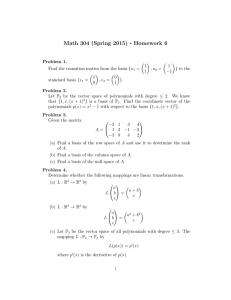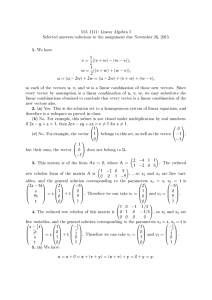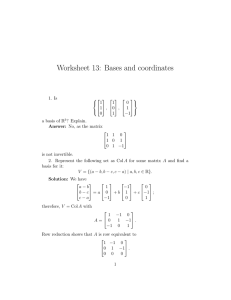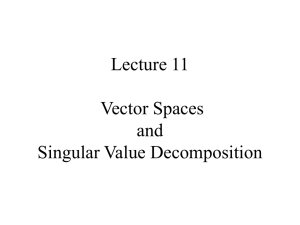Math 304 (Spring 2015) - Homework 6
advertisement
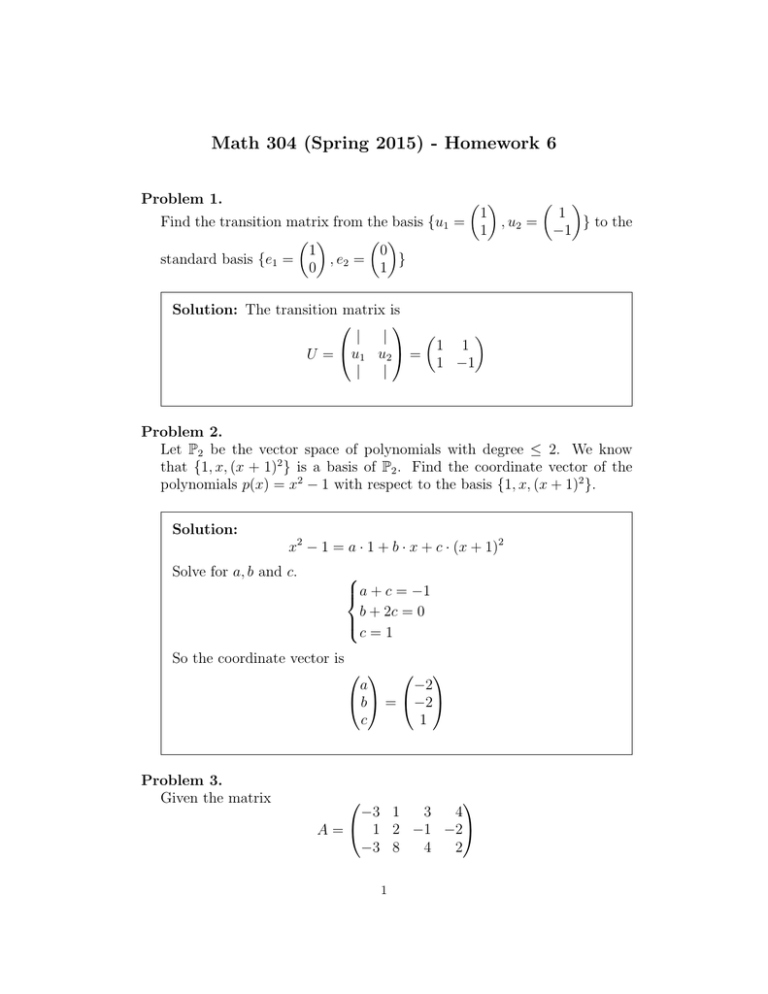
Math 304 (Spring 2015) - Homework 6
Problem 1.
1
1
Find the transition matrix from the basis {u1 =
, u2 =
} to the
1
−1
1
0
standard basis {e1 =
, e2 =
}
0
1
Solution: The transition matrix is
|
|
1 1
U = u1 u2 =
1 −1
|
|
Problem 2.
Let P2 be the vector space of polynomials with degree ≤ 2. We know
that {1, x, (x + 1)2 } is a basis of P2 . Find the coordinate vector of the
polynomials p(x) = x2 − 1 with respect to the basis {1, x, (x + 1)2 }.
Solution:
x2 − 1 = a · 1 + b · x + c · (x + 1)2
Solve for a, b and c.
a + c = −1
b + 2c = 0
c = 1
So the coordinate vector is
a
−2
b = −2
c
1
Problem 3.
Given the matrix
−3 1
3
4
A = 1 2 −1 −2
−3 8
4
2
1
(a) Find a basis of the row space of A and use it to determine the rank
of A.
(b) Find a basis of the column space of A.
(c) Find a basis of the null space of A.
Solution:
(a) Row echelon form of A is
1 2 −1
−2
0 1
0 −2/7
0 0
1
0
So
u1 = (1, 2, −1, −2)
u2 = (0, 1, 0, −2/7)
u1 = (0, 0, 1, 0)
form a basis of the row space of A. So the rank of A is 3.
(b) By looking at the pivotal entries of the echelon form of A, we see
that
3
1
−3
v1 = 1 , v2 = 2 , v3 = −1
4
8
−3
form a basis of the column space of A.
(c) All solutions are of the form
10/7
2/7
s
0
1
So
10/7
2/7
w=
0
1
forms a basis of ker A.
Problem 4.
2
Determine whether the following mappings are linear transformations.
(a) L : R3 → R2 by
a
a
+
b
L b =
c
c
(b) L : R3 → R2 by
2
a
a + b2
L b =
c
c
(c) Let P3 be the vector space of all polynomials with degree ≤ 3. The
mapping L : P3 → P3 by
L(p(x)) = p0 (x)
where p0 (x) is the derivative of p(x).
(d) L : P2 → P3 by
L(p(x)) = x · p(x)
(e) L : P2 → P3 by
L(p(x)) = p(x) + x2
Solution: For this question, I will skip the details.
(a) Yes.
(b) No.
(c) Yes.
(d) Yes.
(e) No.
Problem 5.
Find the matrix representations of the following linear transformations.
(a) Let L be the linear transformation from R3 to R3 by
x1
2x1 − x2 − x3
L x2 = 2x2 − x1 − x3
x3
2x3 − x1 − x2
Find the standard matrix representation of L.
3
(b) The vectors
1
1
0
v1 = 1 , v2 = 0 , v3 = 1
0
1
1
form a basis of R3 . Let L be the linear transformation from R2 to R3
defined by
x
L 1 = x1 v1 + (x2 + x1 )v2 + (x1 − x2 )v3 .
x2
Find the matrix representation of L with respect to the bases {e1 , e2 }
(the standard basis of R2 ) and {v1 , v2 , v3 }.
(c) The vectors
0
1
1
v1 = 1 , v2 = 0 , v3 = 1
1
1
0
form a basis of R3 . Let L be the linear transformation from R2 to R3
defined by
x
L 1 = x1 v1 + (x2 + x1 )v2 + (x1 − x2 )v3 .
x2
Find the matrix representation of L with respect to the standard
bases.
Solution:
(a)
2
−1
−1
2 , L(e3 ) = −1
L(e1 ) = −1 , L(e2 ) =
−1
−1
2
The standard matrix representation is
2 −1 −1
−1
2 −1
−1 −1
2
(b)
L(e1 ) = v1 + v2 + v3
4
so its coordinate vector with respect to {v1 , v2 , v3 } is
1
1
1
Similarly, the coordinate vector of L(e2 ) is
0
1
−1
So the matrix representation is
1
0
1
1
1 −1
(c)
2
L(e1 ) = v1 + v2 + v3 = 2
2
so its coordinate vector with respect to the standard basis {e1 , e2 , v3 }
of R3 is
2
2
2
Similarly, the coordinate vector of L(e2 ) is
1
−1 .
0
So the matrix representation is
2
1
2 −1
2
0
5
